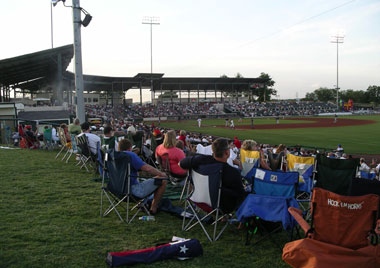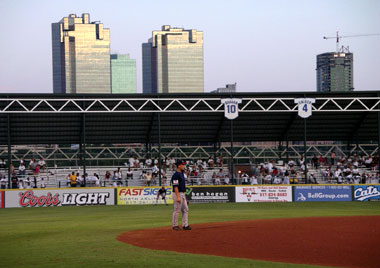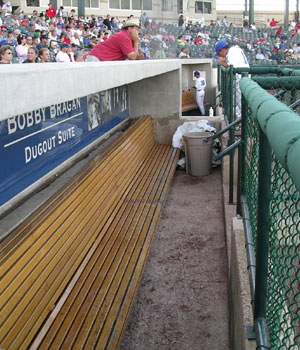
|
Despite dating only to 2002, Fort Worth’s intimate LaGrave Field has the charm associated with classic ballparks of a bygone era, when frills were kept to a minimum, and the focus was on baseball, not amenities.
Sure there are a couple of nice touches, but if you ignore the ballpark’s pristine condition, it would be entirely believable that the Cats had been playing at the intersections of Main Street and Seventh Avenue since the original LaGrave was built in 1926. Instead, the original Cats franchise abandoned the city in 1958 and didn’t return to LaGrave until 2002, when a brand new, $4-million ballpark opened on the exact site of its predecessor, which had been torn down in 1967. The ballpark is advanced for a team playing in an independent league, but suitable for a city with a population of a half million folks. LaGrave’s most distinctive feature is that it takes advantage of its proximity to downtown Fort Worth. Located only about a half mile away, the ballpark has an impressive view of the city’s skyline, and the tall buildings that glisten in the sun and are lit up when it goes down at night. Other than that, LaGrave is tucked away in a backdrop of open space and trees. Despite its relatively small size, LaGrave has seating from foul pole to foul pole, a bleacher section in left field, and a nostalgic covered grandstand in right field. It also has a berm section down the right field line, the one modern nod to ballpark construction that is always a hit with fans. Although the capacity is listed as 5,100, the ballpark can actually hold many more, and the team set a Central League record in 2003 when 9,216 fans attended a game on the 4th of July. LaGrave's main grandstand features a wide covered concourse behind the box seats in full view of the playing field, which means you can roam freely about the ballpark and not obstruct anybody’s view when you choose to stop and watch the game. The only setback to the design is a lack of permanent bathrooms, which are instead located behind the ballpark in trailers down the outfield lines. Mixing the traditional with the new, LaGrave’s main scoreboard is hand operated, and features a video board with player photos (but not stats). Another throwback is the clock, which has hands, not digits. The Cats also have two mini electronic scoreboards that can be seen by fans sitting in the outfield bleachers.
Something very unique at LaGrave Field is their approach to luxury suites, which are entirely absent in a traditional sense. Instead, the Cats offer two restored dugout suites from the original LaGrave Field and located them right next to the real dugouts, with only a small partition separating suite holders from players. The dugouts (past and present) aren’t that big, so baseball is the only form of entertainment available. If it’s pool tables and televisions that you want, you’ve come to the wrong place. If interested, each “suite” goes for $500 per game and holds up to 10 people. Included in the price are 20 hot dogs, 24 sodas, 10 boxes of popcorn, and 10 adjustable Fort Worth caps.
AtmosphereThe city has embraced the Cats, who lead the league in attendance. The ballpark was lively and the fans very knowledgeable. A few vocal flag waving diehard fans even manned the hill behind the left field bleachers. The team carries on two traditions: fans stand until a Fort Worth pitcher throws his first strike, and ushers pass the boot when a Cats' batter hits a home run. Since Ft. Worth plays in an independent league, they are not subject to the rules and restrictions placed on minor league teams affiliated with Major League Baseball. I’d been to two independent games in the past, and both had many distractions not normally associated with a baseball game, but my experience in Ft. Worth was extremely professional. The only unusual event occurred when the Cats’ mascot, which bears a close resemblance to the cat from the Itchy & Scratchy Show on The Simpsons, jumped off the top of the third base dugout and ran across the field (behind home plate) to the first base dugout in the late innings.
Parking, Tickets, & ConcessionsThere is ample parking surrounding the ballpark, but the Cats charge $3 to park in it, which is high compared to many minor league ballparks (many of whom charge nothing). The good news is that even with a large crowd, cars can exit quickly after the game. The ushers let you move about the ballpark freely, so you can buy a cheap ticket in the outfield or berm and then move to a better seat if you choose. The one area to stay away from is the lower levels of the Field Box (sections E, F, M, N) where the seating section, which isn’t easily assessable to begin with, dips below the playing field, causing a lot more strain than necessary. It's like having to watch a movie from the first few rows in a theatre. The cheap outfield seats are actually a great place to watch the game, although you won’t have the view of downtown Ft. Worth from the right field grandstand. There are also a number of tables on the wooden plaza in left field that seat four people for $36. All but one of the concession stands are located on the main concourse, and the most interesting item I saw was a fried Snickers bar for $2.50. Hot dogs and burgers are grilled behind first base, and puffs of smoke wafted over the field from time to time.
HistoryProfessional baseball has a rich tradition in Fort Worth, where the rain check was invented in 1910 by the Panthers, a founding member of the original Texas League in 1888. During the golden era of minor league baseball in the 1940’s and 50’s, the team, having changed their name to the Cats, spent eleven seasons as a Brooklyn Dodgers affiliate at the original LaGrave Field, which was a 12,500 seat double-decker stadium named in honor of Paul LaGrave, the business manager who ran the team from 1916 until his death in 1929. Affiliated minor league baseball left the city for good in 1964 when the push to bring in a Major League team eventually landed the Texas Rangers just 17 miles away in neighboring Arlington, and since the Rangers control “territorial rights” to the area a team couldn’t be placed in Ft. Worth without their approval. As a result, professional baseball remained absent from Ft. Worth for nearly 40 years until the Cats franchise was reborn in the independent leagues, starting with the All American Association in 2001. When that league folded, the Cats joined the Central Baseball League (formerly the Texas-Louisiana League) a year later in their brand new ballpark, where home plate still sits exactly where it did more than 75 years ago.
My RecommendationDowntown Ft. Worth is about a half mile away, and although the city is home to the corporate headquarters of Lockheed Martin, American Airlines, and RadioShack, among others, if you’re looking for something to do, head down to the historic Fort Worth Stock Yards, about two miles away. There you will find a number of rodeo and western-themed things to do. Something you don’t want to miss is the world's only daily Cattle Drive. The Fort Worth Herd are driven at 11:30 am and 4:00 pm every day of the week. After watching the cattle run through the streets of the Stock Yards you can choose your pregame meal from a number of steakhouses and restaurants. I ate at Riscky’s, which has four separate restaurants in the Stock Yards – seafood, BBQ, Mexican and steak. After eating head over to LaGrave Field, where you’ll probably be entitled to a freebie from one of the team's many promotions. Buy an outfield seat and you’re free to move around. Also, the game programs aren’t the generic, printed before the season kind that often feature little more than advertising. The Cats’ program has plenty of information on the team and players and is worth the $3. The program also includes an up-to-date insert featuring stats from both teams and league standings. Although I didn’t get a chance to eat one, spend $2.50 on a fried Snickers at the concession stand and let me know how it is.

LaGrave Field Footnotes - Facts & Figures
| |||||||||||||||||||||||||



 Furthermore, fans can watch the game from outside of the ballpark, directly behind the left field bleachers, without having to pay. The bleachers stop parallel with the crest of the hill directly behind them and offer a great vantage point of the vast majority of the playing field.
Furthermore, fans can watch the game from outside of the ballpark, directly behind the left field bleachers, without having to pay. The bleachers stop parallel with the crest of the hill directly behind them and offer a great vantage point of the vast majority of the playing field.

